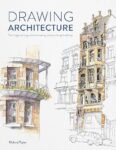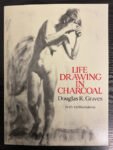It's been a busy day as I've been making notes on this book that I…

Drawing With Charcoal, Kate Boucher – Book Review
Ok, let’s have one more book review. This was the first book. I read after the first batch of birthday presents arrived as I was keen to read any advice it had on what paper and fixative to buy to do with my charcoal pencils as I’m itching to get started with them. I was wondering whether to hold back on this review until I’d started using charcoal but I actually already have a pretty good idea about this book’s merits. So let’s go.
This is a 144 page paperback, divided into six chapters on materials, what to draw, basic mark making, advanced mark making, framing/fixing/etc and on introducing soft pastels as an extra medium. I was hoping this book would be a good introduction to drawing with charcoal and this already sounds good. Let’s go through those sections one by one.
The introduction chapter lay good. There’s other stuff I need apart from charcoal. Paper and fixative. I need stumps, cloths, different sorts of eraser and there’s even other stuff that could be useful. Kate’s not too dogmatic about the choice of paper, pointing us towards thick, acid–free paper if anything and leaving it up to us to experiment with rough and smooth surfaces. The first indication of Kate’s style which is to throw out some ideas and encourage us to work out for ourselves how we prefer to work. Because my tinted charcoal includes a white, my choice of paper was limited; I’ve ordered some tinted pastel paper but it’s not quite as heavy as the paper Kate likes to use.
Then there’s a chapter on how to choose something to draw. Kate talks about getting us to use our “charcoal eyes” but it felt to me on the one hand like this was just talking about our artistic eyes and that the ideas in this chapter could be applied to choosing subject matter for any artistic medium. On the other hand, the introduction of some randomness into subject selection may just be a sneaky way of getting the reader to loosen up mentally to prepare to start painting in what’s a pretty loose medium. If this was the plan, then that’s genius. Otherwise it’s just a happy little accident and we all like those, don’t we?
Then we have the important chapter on mark making. We can make marks in lots of different ways with with each of charcoal, smoothing tools (cloths, fingers, kitchen paper, paper stumps) and erasers (rubber, putty) so there’s a lot to talk about here. Kate sets the reader loads of exercises to explore these different types of mark, shows a few photos of her own attempts and throws out a few ideas on variations to the experiment that we could try. It’s an unusual way to teach us but I like it a lot. It pitches the teaching style right on that sweet spot between telling us everything and telling us nothing. I can’t wait to try out my charcoal pencils after reading this chapter.
Then we get a chapter more advanced, avant garde techniques. The charcoal equivalent of painting watercolour with twigs and gesso. If Ann Blockley, Jane Betteridge or Carole Robson ever dumped the watercolours and started using charcoal, I’m sure this is the sort of stuff they’d be doing and writing books on. As well as this, there a also some interesting examples showing how easy it is to correct huge errors in charcoal drawings and how what started as errors can end up making a painting interesting.
Then we have a chapter on fixing, photographing, framing and storing. The bits on fixing were of most use to me here.
And finally there’s the chapter on introducing soft pastels. I was only talking earlier today about how I like it when the bonus chapter at the end of a book starts talking about abstractification but tend to be turned off by bonus chapters on mixed media. But I quite like this chapter. While there’s some stuff in there that’s specific to soft pastels, there are also lots of higher level ideas around introducing a splash of colour to a black, white and grey painting. So a lot of this chapter applies equally to the tinted charcoal pencils that I’ll be using. But it also got me thinking about the approach I took with the markers to United Underworld and whether I could try a similar approach to figure drawings with inktense pencils.
So, as you can probably tell, I’m feeling really happy about this book. It’s a perfect beginners’ book on charcoal, answering all the important questions while also teaching us in a non–dogmatic way, encouraging us to experiment and work out what equipment and techniques suitability best. There’s the odd demo in there but they didn’t feel like demos (let alone paint along with me recipes): they were just part of the story. What else? Did the artist have a voice and a personality? Yes. Was her artwork inspirational? Yes. Amazing book. Five palettes all day long.
🎨🎨🎨🎨🎨
Oh, sorry, one little afterthought. This is a book about how to use charcoal if you can already draw. But surely anyone getting into charcoal has experience of other media, so can already draw, can’t they? I can’t believe anyone will kick off their artistic career with charcoal; it’s way too messy. But there really is someone out there who’s determined to go in at the deep end, I’d advise them to buy a pencil and either this book or this one and, only after learning how to draw, move on to this book and to charcoal.
You can find this book and more reviews of it at Amazon UK here. As an Amazon Associate, I earn commission from qualifying purchases but this costs absolutely nothing extra to you.








Leave a Reply